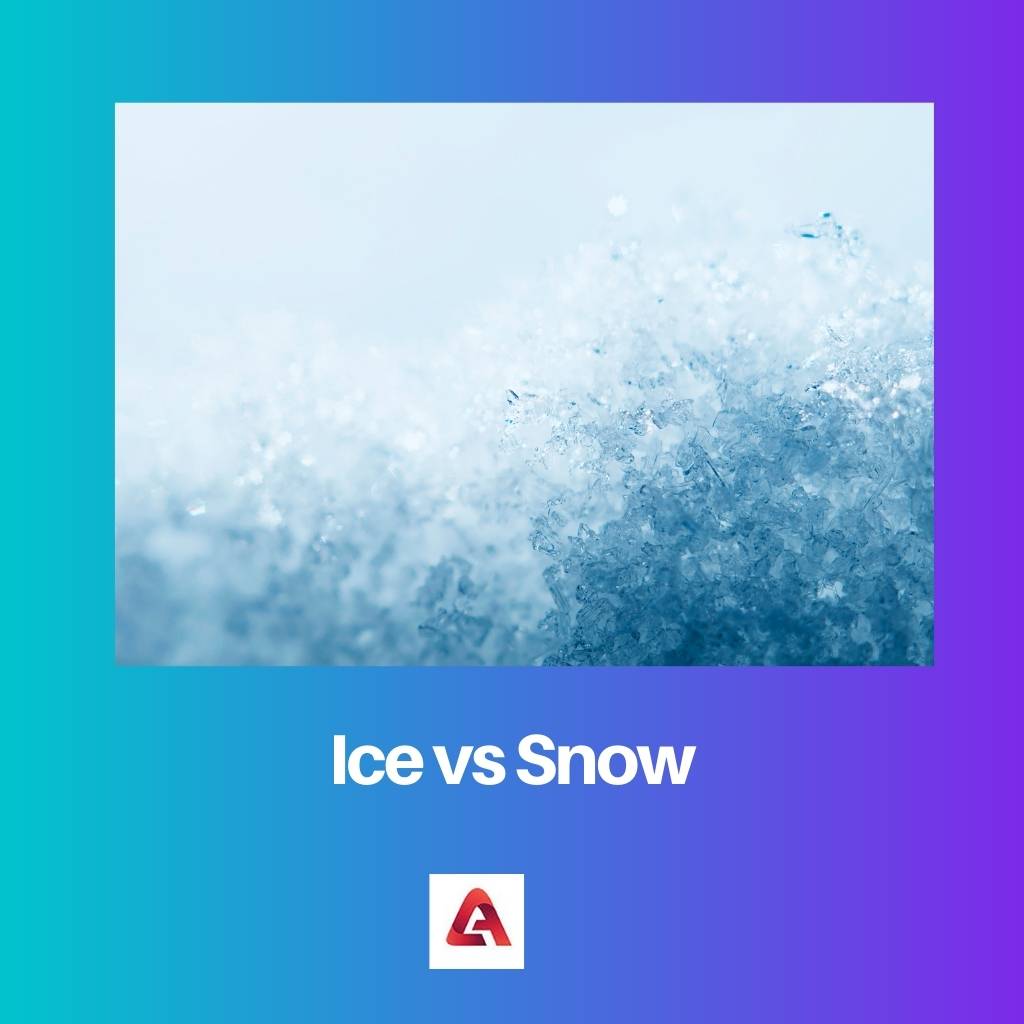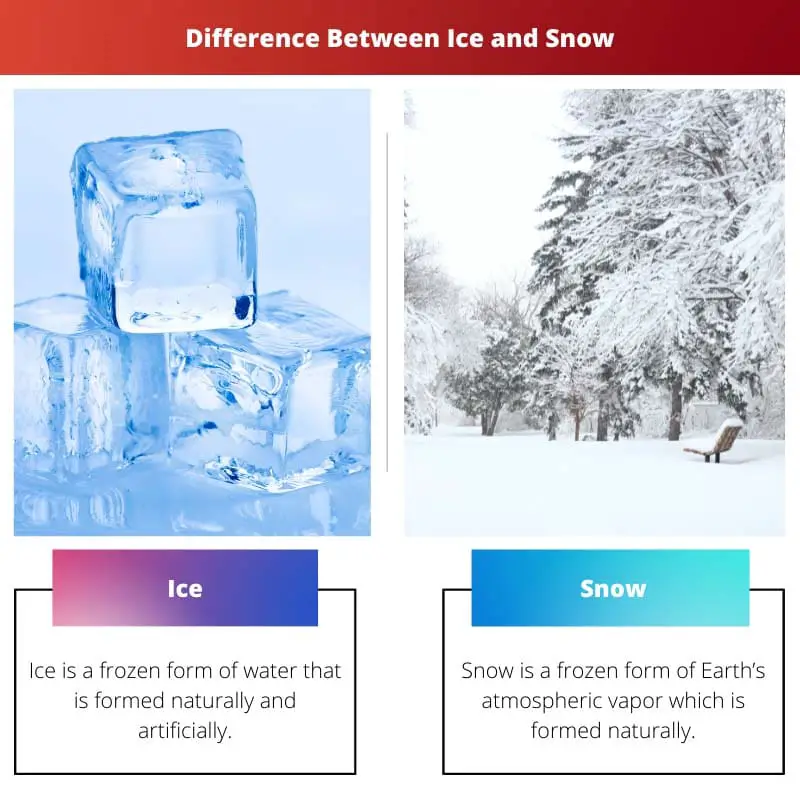Ice and Snow are both various forms of water. Water is an essential component of the Earth’s crust. More than 70% of the Earth is composed of water.
There are various forms of water, of which Ice and Snow are various states of water. Ice is a solid state of water. Snow is a frozen form of water vapour present in the Earth’s atmosphere.
They are in the form of flakes. The chemical composition of both is the same, but they differ in their formation and physical state.
Key Takeaways
- Ice forms when water freezes, while snow results from frozen water vapor in the atmosphere.
- Ice is solid, smooth, and transparent, while snow comprises individual ice crystals.
- Ice poses a greater risk for accidents due to its slippery nature, while snow can be compacted for traction.
Ice vs Snow
Ice is formed when liquid water freezes into a solid state at a temperature of 0°C (32°F) or below. Ice can be found in various forms, such as ice cubes, icicles, glaciers, and icebergs. Snow is formed when water vapour freezes into ice crystals, which clump together to form snowflakes. Snow is associated with cold weather and can accumulate in large quantities on the ground.

Ice is formed when water is frozen either naturally or artificially using cool frozen winds. Cool frozen winds convert water into its solid form.
Ice cubes are used in turning things such as deserts, drinks, and creams into frozen form. There are various forms of ice, such as block ice, crushed ice, crescent ice, full cube, nugget ice, and so on.
Snow is a soft white flake that is formed by frozen precipitation of ice crystals. It is formed naturally due to variations in environmental conditions. It naturally falls on the earth during the winter season.
Snow is a frozen atmospheric vapour. Artificial Snow becomes icy after some time which is not a real Snow characteristic.
Comparison Table
| Parameters of Comparison | Ice | Snow |
|---|---|---|
| Definition | Ice is a frozen form of water that is formed naturally and artificially. | Snow is a frozen form of Earth’s atmospheric vapor which is formed naturally. |
| Formation | Ice can be formed naturally using cool frozen winds, while it can be formed artificially using refrigerators. | Snow can be formed only during changes in seasonal variations. |
| Sports | Ice can be used in Ice Skating. | Snowboarding is an activity that is played during the winter season. |
| Beverages and Desserts | Ice is used as a medium to create various types of desserts and beverages. | Snow is not used as a cooling medium for preparing food. |
| Types | Crushed ice, crescent ice, nugget ice, block ice, cubes, spheres. | Powdery snow, light snow, spring snow, graupel, wet snow. |
What is Ice?
Ice is a product of water formed when water is in its frozen form. There are various types of forms of Ice, which have their own features, melt rate, applications, usage, and benefits.
Ice has the same chemical formula, which has the ice-to-water ratio. Various Ice machines help in its formation artificially.
Regular Ice cube is solid build in its feature, it is used for commercial purposes, with a slow melt rate. It provides maximum cooling and reduces the consumption of Ice.
Full Ice cube is used in bagging, dispensing, and cooling drinks and has a slow melt rate. It is used in restaurants, convenience stores, and catering.
Half Ice Cube is convenient in size and is used universally in restaurants and various convenience stores. Its melt rate is moderate. It is versatile and provides maximum cooling.
Nugget Ice cube is very soft and easy to chew. It is used in blended drinks, soft drinks, and frozen drinks. It blends well and easily absorbs. It has a quick melt rate.
Flake Ice is soft and snow-like. It has a quick melt rate. It is used in fish markets, buffets, and healthcare services. It cools injuries without too much pressure on the wounds.
Crescent Ice and Gourmet Ice are in various shapes used in restaurants and have a slow melt rate.

What is Snow?
Snow is formed due to atmospheric conditions in the Earth’s crust. That leads to the formation of Snow. There are various types of Snow crystals, Snowfall, Snow cover, and Snow formations.
Snowflakes, Hoarfrost, Graupel, and Polycrystals, are the various types of Snow crystals.
Snow falls in the form of pieces depending on their sizes and shapes. Snowstorms, blizzards, Snow flurry, Snow Squall, Blowing Snow, and Drifting Snow are various types of Snow falls.
A snowstorm is one in which there are large amounts of snow that fall on the Earth. Snow, if when blown by the wind, can be classified as blowing snow and drifting snow.
Snow cover occurs when there are piles and packs of snow that have already fallen and are added to the new pack of snowfall.
There are various types of snow cover, such as Seasonal snow, Perennial snow, Old snow, New snow, and Powder snow. They differ in their deposits.
There are various types of Snow Formations, and Snow formations can be formed due to changing temperatures, blowing winds, and seasonal variations.
Crust, Cornice, Ripple marks, Sun cups, and Snow rugs are various types of snow formations. Snow formations lead to formations of different types and shapes of snow.

Main Differences Between Ice and Snow
- Ice is formed as the product of water frozen due to circulating temperatures, whereas Snow is formed as a by-product of change in the atmospheric pressure due to blowing cool winds, which are caused by frozen atmospheric vapour.
- Ice has an ice-to-water ratio with solid features and melts rates, whereas Snow has a water-to-vapour ratio with varying features and melt rates.
- Ice can be used as a cooling agent in food and beverages, whereas Snow is not used for the food and dessert cooling process.
- Ice can be formed naturally and artificially, whereas Snow is only formed artificially. Snow formed artificially does not withstand its unique features. Snow becomes icy when formed artificially.
- Ice has its types and variations in its shapes and melting points. Snow has various forms and types in its occurring and formations. It has various applications and benefits.





